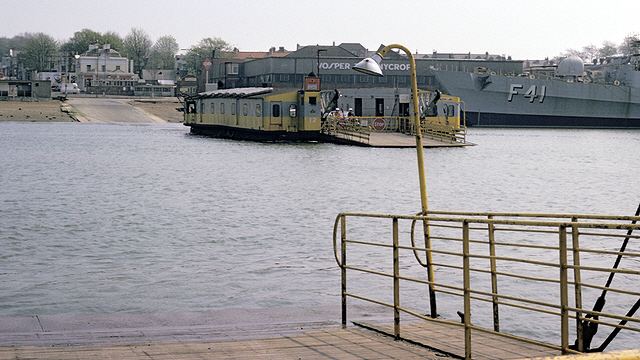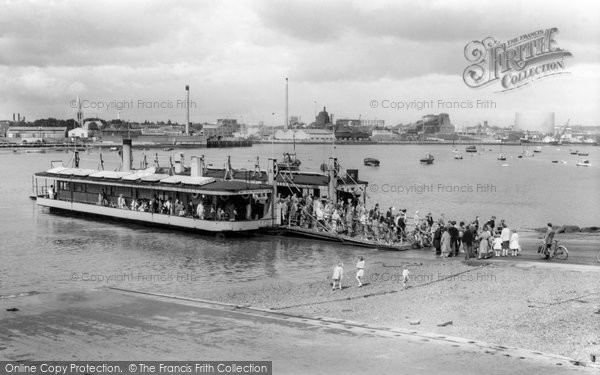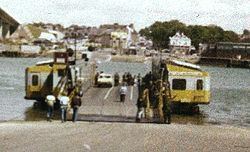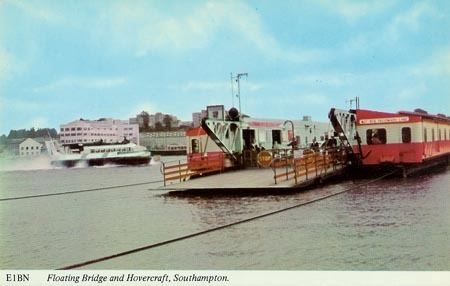 | ||
Similar | ||
Woolston floating bridge in lego bright bricks timelapse
The Woolston Floating Bridge was a cable ferry that crossed the River Itchen in England between Woolston and Southampton from 23 November 1836 until 11 June 1977. It was taken out of service when the new Itchen Bridge was opened.
Contents
- Woolston floating bridge in lego bright bricks timelapse
- Woolston floating bridge top 5 facts
- Planning stage
- Technology
- Naming
- Associated buildings
- Impact on the area
- The Woolston Ferry
- The ferry today
- References

Initially there was one ferry, built and owned by the Floating Bridge Company, increased to two in 1881. In 1934 they were sold to Southampton Corporation.

By 1977, they were operating side by side during the day with a single ferry late in the evening. There was a bus terminus at either side of the crossing, connecting foot passengers with the centre of Southampton and the road to Portsmouth.

Woolston floating bridge top 5 facts
Planning stage

The original plans were introduced in 1833 for a conventional bridge with a swivelling section in the middle. Opposition came from a number of sources including local fishermen and the Northam Bridge Company. An attempt to obtain an article of parliament for the bridge's construction was made in early 1834 but at this point the Admiralty voiced its objection arguing that the bridge would interfere with the navigation of the Itchen. The Admiralty suggested a steam driven floating bridge as an alternative and a revised bill was passed on the 25 July 1834 despite further opposition from the Northam Bridge Company.
Technology

When introduced in 1838, it was a wooden-hulled chain ferry designed by engineer James Meadows Rendel. Initially there was one pair of chains across the river, both being used for propulsion. With the introduction of the lighter iron-hulled ferry No 2 in 1854, only the north chain was used for propulsion, the second chain being for guidance only.

In 1879 a pedestrian-only ferry was introduced, followed by a second in 1881 to service the growing workmen traffic heading for the Thorneycroft shipyard just downstream from the crossing. This necessitated the installation of a second set of chains to allow both types of ferry to operate simultaneously.
In 1880 the ferry was still using chains, replaced by cables between 1878 and 1887. They are first seen in pictures of Floating Bridge No. 7, built in 1892 by Day, Summers and Co. Each rope weighed nearly 2 tons and had an average life of nine months in normal use. Each end was attached to a short length of chain that was connected to counterbalance weights housed in chain wells to maintain tension. As the ropes stretched with use, chain links were removed to compensate.
Floating Bridge No. 11 and the two subsequent ferries were powered by diesel engines.
Originally the ferries were lit by oil lamps. Ferry No 3 was fitted with gas lamps from new in 1862 but reverted to oil in 1869. In the early 20th century, electric lights were fitted to No 8, powered by a steam-driven dynamo, replaced by a Lister diesel in 1949.
One of the diesel ferries was moored at the Woolston slipway as "Floaters" nightclub for some years after withdrawal.
Naming
The Floating Bridge was technically the Woolston ferry.
Floating bridge is an affectionate description of the technology rather than the name of the crossing. The term was first used by the engineer James Meadows Rendel, who had previously implemented a similar design of chain ferry at Torpoint in Cornwall and at Dartmouth in Devon. The same technology was applied to the Gosport Ferry in 1840
No variant of the ferry took the form of a pontoon bridge spanning the whole width of the crossing, to which the term Floating Bridge is more widely applied and thought of today.
The term Floating Bridge has been commonly used in Southampton and it is still in use, more than 30 years after the ferry was taken out of service. The terminology was immortalised in the 1956 painting "The Floating Bridge" by L. S. Lowry.
The term Floating Bridge has also been applied to the Cowes Floating Bridge, which still provides a similar service in a similar situation just a few miles away, across the River Medina in Cowes on the Isle of Wight.
Associated buildings
In 1820, whilst the crossing was still served by the small boats of Itchen Ferry village, a toll house was built. This became a Coffee Tavern when a ticket office was built for the ferry in 1836. The toll-house/Coffee Tavern building survived until 1970. The Ticket Office was demolished in 1954.
Impact on the area
St Johns Road in Hedge End was constructed, starting in 1839, to serve the ferry. This project was initiated by four of the proprietors of the Floating Bridge company, including James Warner the Younger of Botley, Hampshire, and was undertaken at their own expense. There was competition between the ferry and the Northam Bridge, which at the time was a toll bridge. By building a road that linked the hamlet of Hedge End to the Portsmouth Road at Sholing, the proprietors of the Floating Bridge company were able to poach some of the passengers that would otherwise have used Northam Bridge. The road cut through Botley Common and Netley Common. The inevitable further development alongside the road further eroded the common land, and helped the hamlet of Hedge End to establish itself as a village in its own right.
"The Woolston Ferry"
"The Woolston Ferry" is a 1977 folk song, by Gutta Percha and The Balladeers.
If you are ever up in Sholing and you want to go to town,
Don't go via Bitterne, that's the long way round,
Take a trip across the ferry, take a trip across the sea
and if you're pedestrian you can go for free.
Oh, the Woolston ferry, it doesn't travel very fast,
It was never built for comfort, it was built to last.
The ferry today
The last surviving ferry is in Elephant Boatyard in Bursledon, a popular restaurant on the River Hamble.
